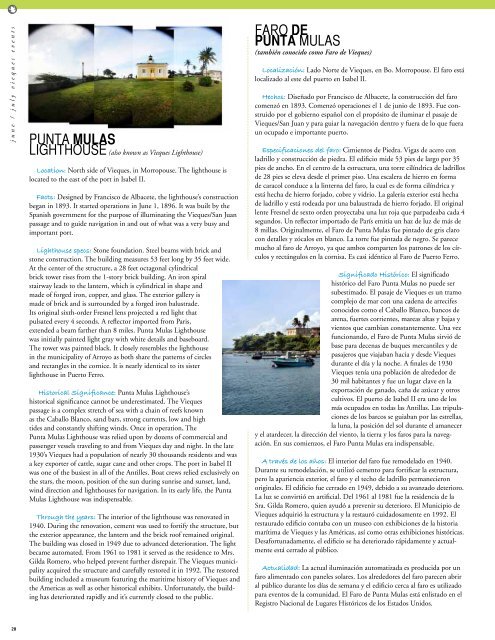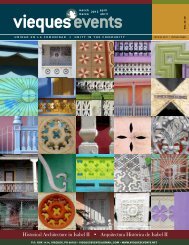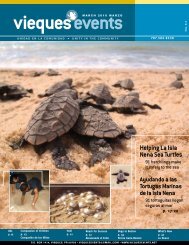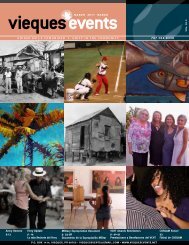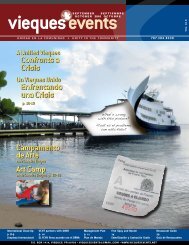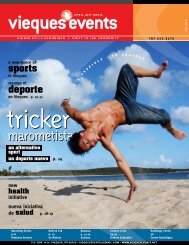alcoholics anonymous - Vieques Events
alcoholics anonymous - Vieques Events
alcoholics anonymous - Vieques Events
You also want an ePaper? Increase the reach of your titles
YUMPU automatically turns print PDFs into web optimized ePapers that Google loves.
june / july vieques events<br />
Punta Mulas<br />
Lighthouse (also known as <strong>Vieques</strong> Lighthouse)<br />
Location: North side of <strong>Vieques</strong>, in Morropouse. The lighthouse is<br />
located to the east of the port in Isabel II.<br />
Facts: Designed by Francisco de Albacete, the lighthouse’s construction<br />
began in 1893. It started operations in June 1, 1896. It was built by the<br />
Spanish government for the purpose of illuminating the <strong>Vieques</strong>/San Juan<br />
passage and to guide navigation in and out of what was a very busy and<br />
important port.<br />
Lighthouse specs: Stone foundation. Steel beams with brick and<br />
stone construction. The building measures 53 feet long by 35 feet wide.<br />
At the center of the structure, a 28 feet octagonal cylindrical<br />
brick tower rises from the 1-story brick building. An iron spiral<br />
stairway leads to the lantern, which is cylindrical in shape and<br />
made of forged iron, copper, and glass. The exterior gallery is<br />
made of brick and is surrounded by a forged iron balustrade.<br />
Its original sixth-order Fresnel lens projected a red light that<br />
pulsated every 4 seconds. A reflector imported from Paris,<br />
extended a beam farther than 8 miles. Punta Mulas Lighthouse<br />
was initially painted light gray with white details and baseboard.<br />
The tower was painted black. It closely resembles the lighthouse<br />
in the municipality of Arroyo as both share the patterns of circles<br />
and rectangles in the cornice. It is nearly identical to its sister<br />
lighthouse in Puerto Ferro.<br />
Historical Significance: Punta Mulas Lighthouse’s<br />
historical significance cannot be underestimated. The <strong>Vieques</strong><br />
passage is a complex stretch of sea with a chain of reefs known<br />
as the Caballo Blanco, sand bars, strong currents, low and high<br />
tides and constantly shifting winds. Once in operation, The<br />
Punta Mulas Lighthouse was relied upon by dozens of commercial and<br />
passenger vessels traveling to and from <strong>Vieques</strong> day and night. In the late<br />
1930’s <strong>Vieques</strong> had a population of nearly 30 thousands residents and was<br />
a key exporter of cattle, sugar cane and other crops. The port in Isabel II<br />
was one of the busiest in all of the Antilles. Boat crews relied exclusively on<br />
the stars, the moon, position of the sun during sunrise and sunset, land,<br />
wind direction and lighthouses for navigation. In its early life, the Punta<br />
Mulas Lighthouse was indispensable.<br />
Through the years: The interior of the lighthouse was renovated in<br />
1940. During the renovation, cement was used to fortify the structure, but<br />
the exterior appearance, the lantern and the brick roof remained original.<br />
The building was closed in 1949 due to advanced deterioration. The light<br />
became automated. From 1961 to 1981 it served as the residence to Mrs.<br />
Gilda Romero, who helped prevent further disrepair. The <strong>Vieques</strong> municipality<br />
acquired the structure and carefully restored it in 1992. The restored<br />
building included a museum featuring the maritime history of <strong>Vieques</strong> and<br />
the Americas as well as other historical exhibits. Unfortunately, the building<br />
has deteriorated rapidly and it’s currently closed to the public.<br />
Faro de<br />
Punta Mulas<br />
(también conocido como Faro de <strong>Vieques</strong>)<br />
Localización: Lado Norte de <strong>Vieques</strong>, en Bo. Morropouse. El faro está<br />
localizado al este del puerto en Isabel II.<br />
Hechos: Diseñado por Francisco de Albacete, la construcción del faro<br />
comenzó en 1893. Comenzó operaciones el 1 de junio de 1893. Fue construido<br />
por el gobierno español con el propósito de iluminar el pasaje de<br />
<strong>Vieques</strong>/San Juan y para guiar la navegación dentro y fuera de lo que fuera<br />
un ocupado e importante puerto.<br />
Especificaciones del faro: Cimientos de Piedra. Vigas de acero con<br />
ladrillo y construcción de piedra. El edificio mide 53 pies de largo por 35<br />
pies de ancho. En el centro de la estructura, una torre cilíndrica de ladrillos<br />
de 28 pies se eleva desde el primer piso. Una escalera de hierro en forma<br />
de caracol conduce a la linterna del faro, la cual es de forma cilíndrica y<br />
está hecha de hierro forjado, cobre y vidrio. La galería exterior está hecha<br />
de ladrillo y está rodeada por una balaustrada de hierro forjado. El original<br />
lente Fresnel de sexto orden proyectaba una luz roja que parpadeaba cada 4<br />
segundos. Un reflector importado de París emitía un haz de luz de más de<br />
8 millas. Originalmente, el Faro de Punta Mulas fue pintado de gris claro<br />
con detalles y zócalos en blanco. La torre fue pintada de negro. Se parece<br />
mucho al faro de Arroyo, ya que ambos comparten los patrones de los círculos<br />
y rectángulos en la cornisa. Es casi idéntico al Faro de Puerto Ferro.<br />
Significado Histórico: El significado<br />
histórico del Faro Punta Mulas no puede ser<br />
subestimado. El pasaje de <strong>Vieques</strong> es un tramo<br />
complejo de mar con una cadena de arrecifes<br />
conocidos como el Caballo Blanco, bancos de<br />
arena, fuertes corrientes, mareas altas y bajas y<br />
vientos que cambian constantemente. Una vez<br />
funcionando, el Faro de Punta Mulas sirvió de<br />
base para decenas de buques mercantiles y de<br />
pasajeros que viajaban hacia y desde <strong>Vieques</strong><br />
durante el día y la noche. A finales de 1930<br />
<strong>Vieques</strong> tenía una población de alrededor de<br />
30 mil habitantes y fue un lugar clave en la<br />
exportación de ganado, caña de azúcar y otros<br />
cultivos. El puerto de Isabel II era uno de los<br />
más ocupados en todas las Antillas. Las tripulaciones<br />
de los barcos se guiaban por las estrellas,<br />
la luna, la posición del sol durante el amanecer<br />
y el atardecer, la dirección del viento, la tierra y los faros para la navegación.<br />
En sus comienzos, el Faro Punta Mulas era indispensable.<br />
A través de los años: El interior del faro fue remodelado en 1940.<br />
Durante su remodelación, se utilizó cemento para fortificar la estructura,<br />
pero la apariencia exterior, el faro y el techo de ladrillo permanecieron<br />
originales. El edificio fue cerrado en 1949, debido a su avanzado deterioro.<br />
La luz se convirtió en artificial. Del 1961 al 1981 fue la residencia de la<br />
Sra. Gilda Romero, quien ayudó a prevenir su deterioro. El Municipio de<br />
<strong>Vieques</strong> adquirió la estructura y la restauró cuidadosamente en 1992. El<br />
restaurado edificio contaba con un museo con exhibiciones de la historia<br />
marítima de <strong>Vieques</strong> y las Américas, así como otras exhibiciones históricas.<br />
Desafortunadamente, el edificio se ha deteriorado rápidamente y actualmente<br />
está cerrado al público.<br />
Actualidad: La actual iluminación automatizada es producida por un<br />
faro alimentado con paneles solares. Los alrededores del faro parecen abrir<br />
al público durante los días de semana y el edificio cerca al faro es utilizado<br />
para eventos de la comunidad. El Faro de Punta Mulas está enlistado en el<br />
Registro Nacional de Lugares Históricos de los Estados Unidos.<br />
28


